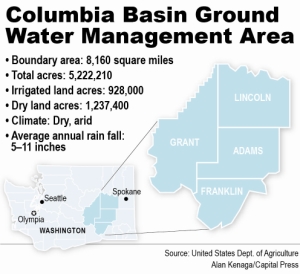forum
library
tutorial
contact

Irrigators Weigh Costs of Surface Water
by Matthew WeaverCapital Press, November 11. 2013
|
the film forum library tutorial contact |

|
Irrigators Weigh Costs of Surface Waterby Matthew WeaverCapital Press, November 11. 2013 |
 Eastern Washington farmers are considering costs to connect their farmland through a pipeline system to receive irrigation water from the Columbia River. The Columbia Basin Development League is working to supplement state funding for expansion of the East Low Canal. Critic Walter Butcher says current expansion efforts won't help reduce the declining aquifer level.
Eastern Washington farmers are considering costs to connect their farmland through a pipeline system to receive irrigation water from the Columbia River. The Columbia Basin Development League is working to supplement state funding for expansion of the East Low Canal. Critic Walter Butcher says current expansion efforts won't help reduce the declining aquifer level.
Farmers irrigating near the Odessa Subarea in Eastern Washington must weigh the costs of connecting their farms to receive water from the Columbia River in the face of a declining aquifer.
The East Columbia Irrigation District is contacting landowners to begin development of layout for pipeline systems.
The district hopes to have preliminary designs of pipeline systems to connect to the East Low Canal in January 2014, said Mike Schwisow, director of government affairs for the Columbia Basin Development League, following the league's annual meeting.
The development league will next look for funding to complete expansion of the East Low Canal, Schwisow said. The state Legislature made a $31.7 million appropriation to develop infrastructure on the Columbia Basin Project, which will go toward widening 43 miles of the canal, and building five siphons and road crossings.
The plan is to use state funds to get as far as possible for the next two years, Schwisow said, running construction during the off-season.
Retired Washington State University agriculture and natural resource economist Walt Butcher said the proposed effort to expand the Columbia Basin Project does nothing to resolve the declining groundwater in the area.
Irrigators and municipalities dependent on the aquifer should meet with Ecology and the Columbia Basin Groundwater Management Area and work out a way to manage the aquifer to use the remaining water in the best possible way, Butcher said.
There are ways to meet the needs of municipalities and supply water for high-value crop production for another 20 to 30 years, by targeting where to continue pumping and where to shut it down, he said.
Butcher said farmers irrigating have indicated in surveys that they're willing to spend about $3,000 per acre to connect to the project. Bureau of Reclamation studies estimate an average of $12,000 per acre, Butcher said, while the Columbia Snake River Irrigators Association estimates costs range from $2,000 an acre to $10,000 for those farmers furthest from the canal.
"It's up to the farmer whether they want to come into the deal or not," Butcher said. "Those that it would cost $10,000 an acre for them to hook up to the canal are not going to be interested in signing up."
He said the size of the project would either have to be reduced to serve those farmers fairly close to the canal, or the state would have to subsidize those farmers who are further away with higher costs.
Schwisow said the real test of whether a project makes sense is whether landowners believe the cost is a good deal and meets their need for a water supply.
The project was intended to address the aquifer problem on a limited basis to maintain the current irrigated base, Schwisow said.
"It's a real-world test, it's not an economic theoretical test based on a rigid, structured formula," he said. "The aquifer is being depleted because the project development didn't continue. You can draw your own conclusions about that."
learn more on topics covered in the film
see the video
read the script
learn the songs
discussion forum
